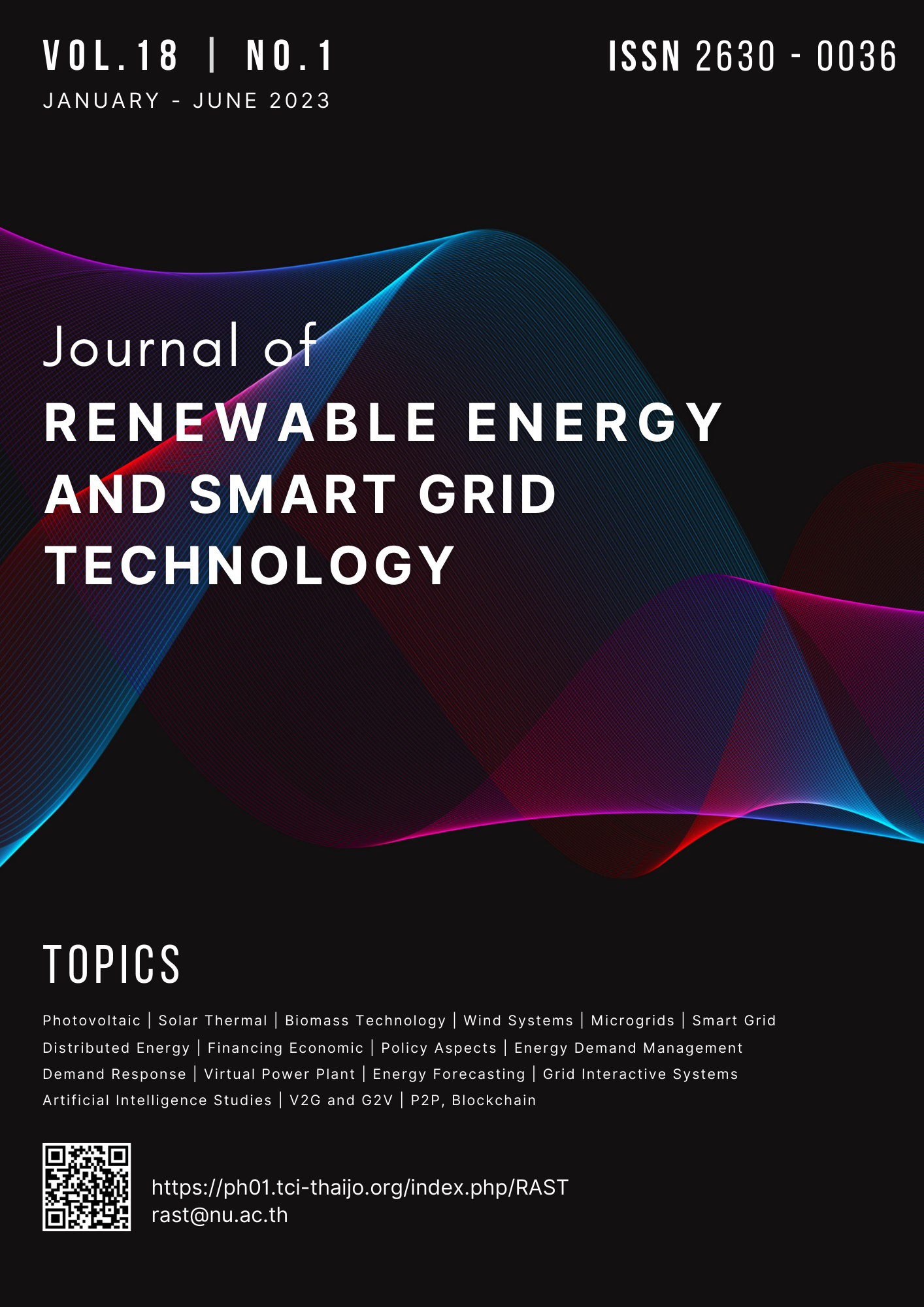An empirical model for estimating the monthly average daily global solar radiation from ground- and satellite-based meteorological data
Keywords:
Ground-based meteorological data, satellite-based meteorological data, solar radiation models, solar energyAbstract
This paper presents an empirical model for estimating the monthly average daily global solar radiation from ground- and satellite-based meteorological data of Thailand. The ground-based meteorological data are visibility, precipitable water, sunshine duration, and cloud fraction, while the satellite-based data are total column ozone. Five-year (2016–2020) ground- and satellite-based data from 14 meteorological stations were used to develop the model, and one-year data (2021) were employed to validate the model. The performance of the developed model was compared with that of seven existing models. It was found that the developed model performed better than the seven existing models. The root mean square difference relative to the mean measured values (RMSD) and the mean bias difference relative to the mean measured values (MBD) of the developed model were found to be 8.1% and 0.4%, respectively. The developed model gave a more accurate value of monthly average daily global solar radiation compared with the seven existing models.
References
Duffie, J. A., Beckman, W. A. & Blair N. (2020). Solar Engineering of Thermal Processes, Photovoltaics and Wind (5th edition). New York, United States: Wiley.
Kimball, H. H. (1919). Variations in the total and luminous solar radiation with geographical position in the United States. Monthly Weather Review, 47(11), 769–793.
Angstrom, A. (1924). Solar and terrestrial radiation. Quarterly Journal of the Royal Meteorological Society, 50(210), 121–126.
Prescott, J. (1940) Evaporation from a water surface in relation to solar radiation. Transactions of the Royal Society of South Australia, 64, 114–118.
Akinoglu, B. G. (1991). A review of sunshine-based models used to estimate monthly average global solar radiation. Renewable Energy, 1(3–4), 479–497.
Sahin, A. D. & Sen, Z. (2008). Solar irradiation estimation methods from sunshine and cloud cover data. In Badescu, V. (ed.) Modeling Solar Radiation at the Earth’s Surface. Berlin, 145–173.
Paulescu, M. (2008). Solar irradiation via air temperature data. In Badescu V. (ed). Modeling Solar Radiation at the Earth’s Surface: Berlin, Springer, 175–192.
Page, I. K. (1961). The estimation of monthly mean values of daily total shortwave radiation in vertical and inclined surfaces from sunshine records for latitude 40°N–40°S. In: Proceedings of the UN Conference on new Source of Energy, 378–390.
Augustine, C. & Nnabuchi, M. N. (2010). Analysis of some meteorological data for some selected cities in the Eastern and Southern zone of Nigeria. African Journal of Environmental Science and Technology, 4(2), 92–99.
Olayinka, S. (2011). Estimation of global and diffuse solar radiations for selected cities in Nigeria. International Journal of Energy and Environmental Engineering, 2(3), 13–33.
Kolebaje, O. T. & Mustapha, L. O. (2012). On the performance of some predictive models for global solar radiation estimates in tropical stations: Port Harcourt and Lokoja. African Review of Physics, 7, 145–163.
Ituen, E. E., Esen, N. U., Nwokolo, S. C. & Udo, E. G. (2012). Prediction of global solar radiation using relative humidity, maximum temperature and sunshine how in Uyo, in the Niger Delta region, Nigeria. Advances in Applied Science Research, 3, 1923–1937.
Ohunakin, O. S., Adaramola, M. S., Oyewolu, O. M. & Fagbenle, R. O. (2013). Correlations for estimating solar radiation using sunshine hours and temperature measurement in Osogbo, Osun state, Nigeria. Frontiers in Energy, 7(2), 214–222.
Falayi, E. O., Adepitan, J. O. & Rabiu, A. B. (2008). Empirical models for the correlation of global solar radiation with meteorological data for Iseyin, Nigeria. International Journal of the Physical Sciences, 3, 210-216.
Dougherty, C. (2002). Introduction to Econometrics. Oxford Univ. Press, Oxford.
Iqbal, M. (1983). An Introduction to Solar Radiation. New York, USA: Academic Press.
Janjai, S., Laksanaboonsong, J., Nunez, M. & Thongsathitya, A. (2005). Development of a method for generating operational solar radiation maps from satellite data for a tropical environment. Solar Energy, 78(6), 739–751.

Downloads
Published
How to Cite
Issue
Section
License
Copyright (c) 2023 School of Renewable Energy and Smart Grid Technology (SGtech)

This work is licensed under a Creative Commons Attribution-NonCommercial-NoDerivatives 4.0 International License.
All copyrights of the above manuscript, including rights to publish in any media, are transferred to the SGtech.
The authors retain the following rights;
1. All proprietary rights other than copyright.
2. Re-use of all or part of the above manuscript in their work.
3. Reproduction of the above manuscript for author’s personal use or for company/institution use provided that
(a) prior permission of SGtech is obtained,
(b) the source and SGtech copyright notice are indicated, and
(c) the copies are not offered for sale.








